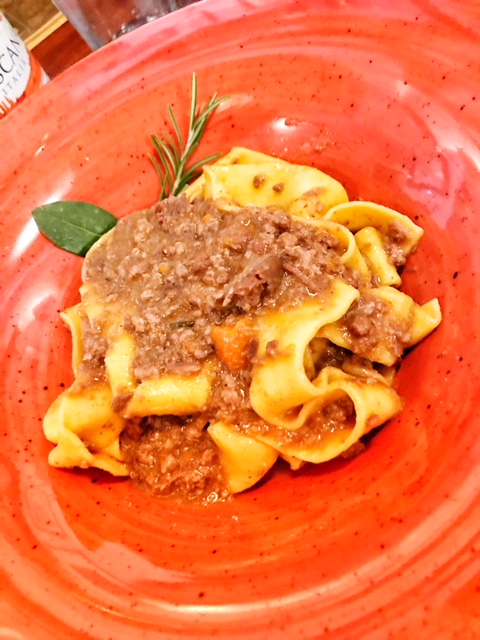I have now been to too many Italian restaurants who claim they make authentic “grandma’s” or “Mamma’s” Bolognese Sauce when in fact they are poor if not pathetic attempts at this classic and, yes, historic Italian staple. The last straw was when I visited the newly opened Rossoblu in Los Angeles, where their claim to fame is to provide a genuine representation of Bolognese cuisine. Fiddlesticks! Rossoblu’s version was watered down, tasteless and thin and lack the luscious and rich flavors this sauce is known for in the Emilia region of Italy. So, here is my recipe, which I guarantee, if you follow the steps I propose below will result in a sauce with depth, flavor, richness and “umami” and which will bring joy to your family friends every time you make it. The ingredients are pretty basic, I add a touch of rosemary to give the sauce some herbaceousness and aroma. The addition of milk at the end, though counterintuitive, is crucial to the success of the sauce and ads the richness one is looking for and cust down on acidity the tomatoes may add. I also add a touch of pancetta at the beginning to add some salt, so be careful not to add any extra salt until the sauce is cooked ort near completion to avoid over salting the dish. Let’s start with the ingredients:
Olive oil – 2-3 Tbls
1 small onion (yellow or red) fine dice
1 carrot fine dice
1-2 stalks of celery fine dice
3-4 good size rosemary branches
4 oz pancetta diced
3/4 lb of ground beef (20% fat)
3/4 lb of ground pork
500 grams “passato”, Italian tomato sauce, I suggest Mutti which can be bough now at Bed Bath and Beyond or specialty Italian stores. Just make sure it is free of citric acid and is as pure as you can find it.
3/4 cup white wine
1/2 cup of milk (this can be increased to 3/4 cup, you want the sauce to have some richness to it and the tomato diluted sufficiently.
Parmesan – I use a couple fistfuls
Cooking water from your pasta, so don’t throw it down the drain.
Salt to taste
Pasta – I prefer Tagliatelle but short pasta works also, such as Rigatoni or similar shapes. Do not use Spaghetti.
Passion and joy.
Start but sauteing on medium flame your pancetta until nice and crisp then add the vegetables (carrots, onion, and celery) increase to medium-high. Be patient, let the vegetables mix with the pancetta and soften, even brown. The more they brown, the more flavor you’ll have in the end. Add the rosemary after a couple of minutes and integrate well into the vegetable mixture. Keep an eye on it, if you feel the flame is too high lower it and let the vegetable mixture do its thing. After about 15-20 minutes, you will see the vegetables have softened, browned a bit and created a nice integrated mixture. At this point, I remove the mixture from the pot and transfer to a bowl. Add an additional tbsp of oil to the pot and add the pork and beef using a wooden spoon to break up and mince the meat so it browns evenly and you are left without any chunks. Here to give the meet a chance to brown so keep the flame “alive” and mix once in a while to avoid sticking and ensuring an even cook. You may want to add just a pinch of salt to flavor the meet, but don’t overdo it. Once the meat has browned add the pancetta and vegetable mixture you had set aside and integrate well with the meat sauteing it for another 2-3 minutes. At this point add the wine, deglaze any sticky bits in the pot. Remember that’s where a lot of the flavor is. Finally, add the “passato” and mix well with the meat-vegetable mixture. If you feel it’s too thick, add ha;lf a cup of water or chicken stock. Bring to a boil and cover leaving a small opening, then simmer for about 2 hours, giving it a mix every 20-30 minutes on a very low flame. You want it to simmer not boil otherwise it will not have time to do its magic. Once done, taste, add salt to your satisfaction then add the milk and mix well ensuring all the ingredients are well integrated. The sauce now should have more of a brownish tint than red and have a rich, thick texture. Let the sauce sit for a while, I actually don’t use it until the next day – letting the sauce sit for 24 hours in the fridge and reheating it the next day gives the flavors a chance to do their magic.
To prepare, boil salted water and add your pasta. Meantime add sauce to a good sized pan, add sauce and heat until bubbling and well mixed. Transfer the cooked pasta, which should be just short of “al dente”, directly from the pot to the saucepan and saute mixing well with a wooden spoon, or if you can flipping the pasta in the pan so it integrates well with the sauce. Add a small ladle of cooking water and continue to mix. Add a fistful or two of Parmiggiano and continue mixing, this creates what is called “la manticatura” or the creaming of the pasta. Repeat one more time for good measure making sure the all the water has evaporated and the pasta/sauce mixture is wet and creamy. Serve and enjoy sprinkling some additional cheese on the plate.

